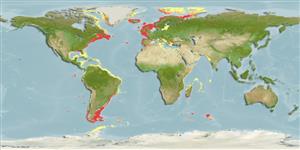Melinna cristata (Sars, 1851)
| Native range | All suitable habitat | Point map | Year 2050 |

|
| This map was computer-generated and has not yet been reviewed. |
| Melinna cristata AquaMaps Data sources: GBIF OBIS |
Envoyez vos Photos
Images Google |
No photo available for this species.No drawings available for Ampharetidae.
Images Google |
No photo available for this species.
Classification / Names Common names | Synonyms | CoL | ITIS | WoRMS
| Terebellida | Ampharetidae
Environment: milieu / climate zone / depth range / distribution range Écologie
; profondeur 27 - 237 m (Ref. 117328). Polar
Distribution Pays | Zones FAO | Écosystèmes | Occurrences | Introductions
Indo-Pacific, Atlantic Ocean, Mediterranean, Arctic and Antarctic.
Length at first maturity / Taille / Poids / Âge
Maturity: Lm ? range ? - ? cm
Found in muddy bottoms. A surface deposit feeder (Ref. 96501), i.e., a microvore that feeds on organic detritus (Ref. 96352). Also a suspension feeder. Sessile and tentaculate (Ref. 125928). Tubiculous (Ref. 112705).
Life cycle and mating behavior Maturité | Reproduction | Frai | Œufs | Fécondité | Larves
Members of the class Polychaeta are mostly gonochoric (sexual). Mating: Females produce a pheromone attracting and signalling the males to shed sperm which in turn stimulates females to shed eggs, this behavior is known as swarming. Gametes are spawned through the metanephridia or body wall rupturing (termed as "epitoky", wherein a pelagic, reproductive individual, "epitoke", is formed from a benthic, nonreproductive individual, "atoke"). After fertilization, most eggs become planktonic; although some are retained in the worm tubes or burrowed in jelly masses attached to the tubes (egg brooders). Life Cycle: Eggs develop into trocophore larva, which later metamorph into juvenile stage (body lengthened), and later develop into adults.
Référence principale
Références | Coordinateur | Collaborateurs
Piepenburg, D., N.V. Chernova, C.F. von Dorrien, J. Gutt, A.V. Neyelov, E. Rachor, L. Saldanha and M.K. Schmid. 1996. (Ref. 2952)
Statut dans la liste rouge de l'IUCN (Ref. 130435)
statut CITES (Ref. 108899)
Not Evaluated
CMS (Ref. 116361)
Not Evaluated
Menace pour l'homme
Utilisations par l'homme
| FishSource |
Outils
Plus d'informations
Pays
Zones FAO
Écosystèmes
Occurrences
Introductions
Stocks
Écologie
Régime alimentaire
Éléments du régime alimentaire
Zones FAO
Écosystèmes
Occurrences
Introductions
Stocks
Écologie
Régime alimentaire
Éléments du régime alimentaire
Taille/Âge
Croissance
Longueur-poids
Longueur-longueur
Morphologie
Larves
Abondance
Croissance
Longueur-poids
Longueur-longueur
Morphologie
Larves
Abondance
Sources Internet
BHL | BOLD Systems | CISTI | DiscoverLife | FAO(Publication : search) | Fishipedia | GenBank (genome, nucleotide) | GloBI | Gomexsi | Google Books | Google Scholar | Google | PubMed | Arbre de Vie | Wikipedia (Go, chercher) | Zoological Record
Estimates based on models
Preferred temperature
(Ref. 115969): 1.9 - 9.8, mean 4 (based on 877 cells).
Catégorie de prix
(Ref. 80766):
Unknown.


